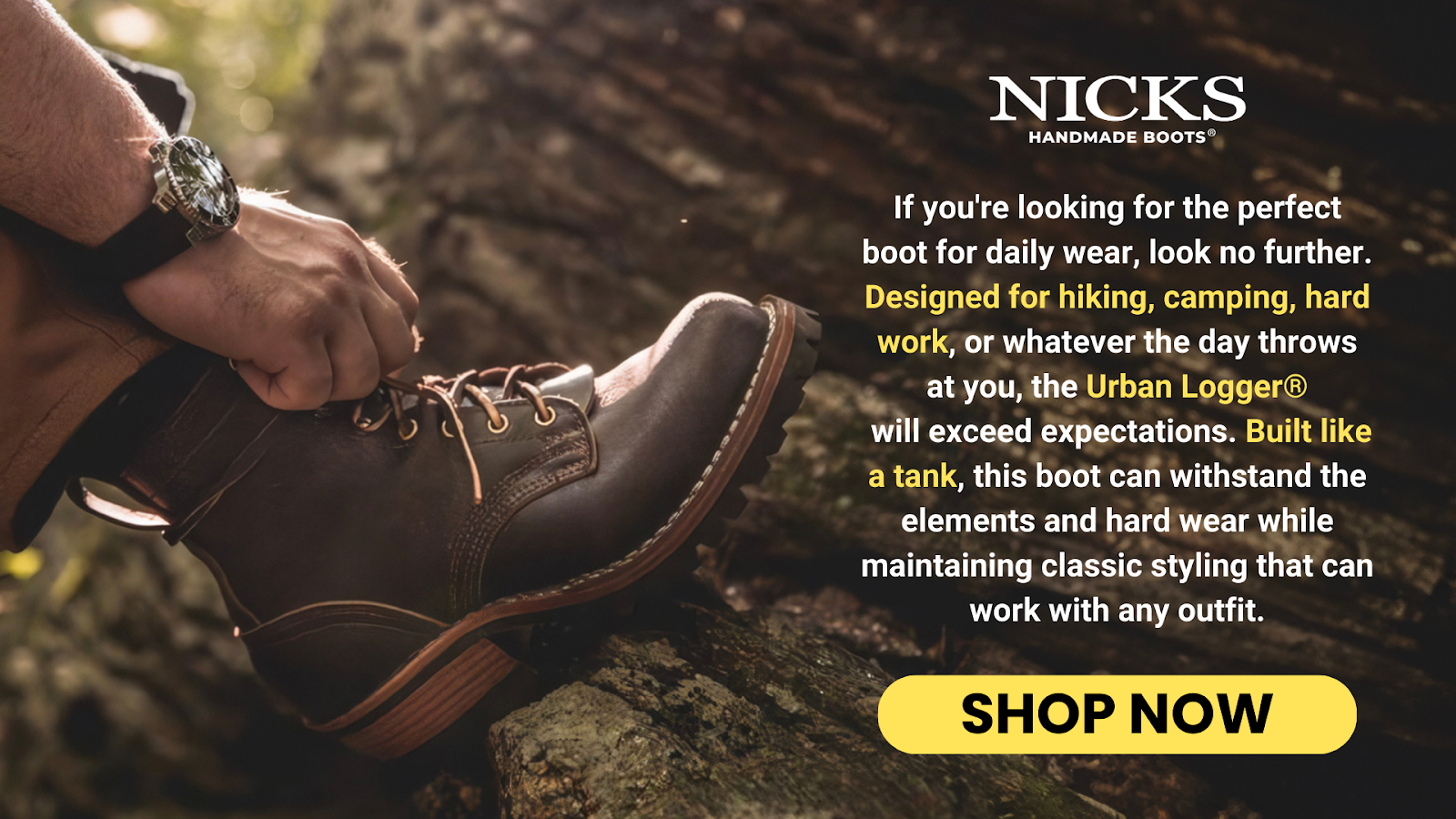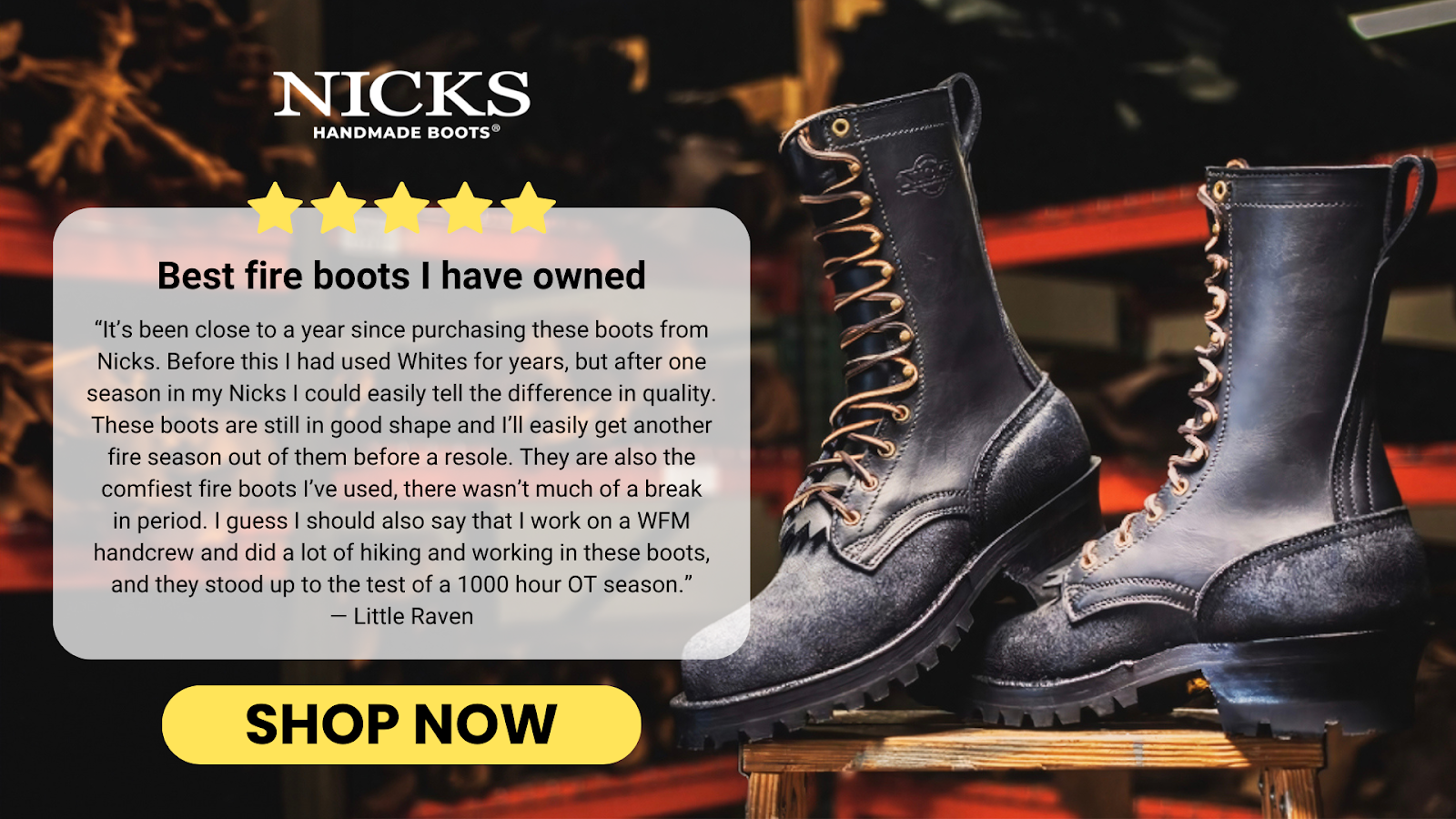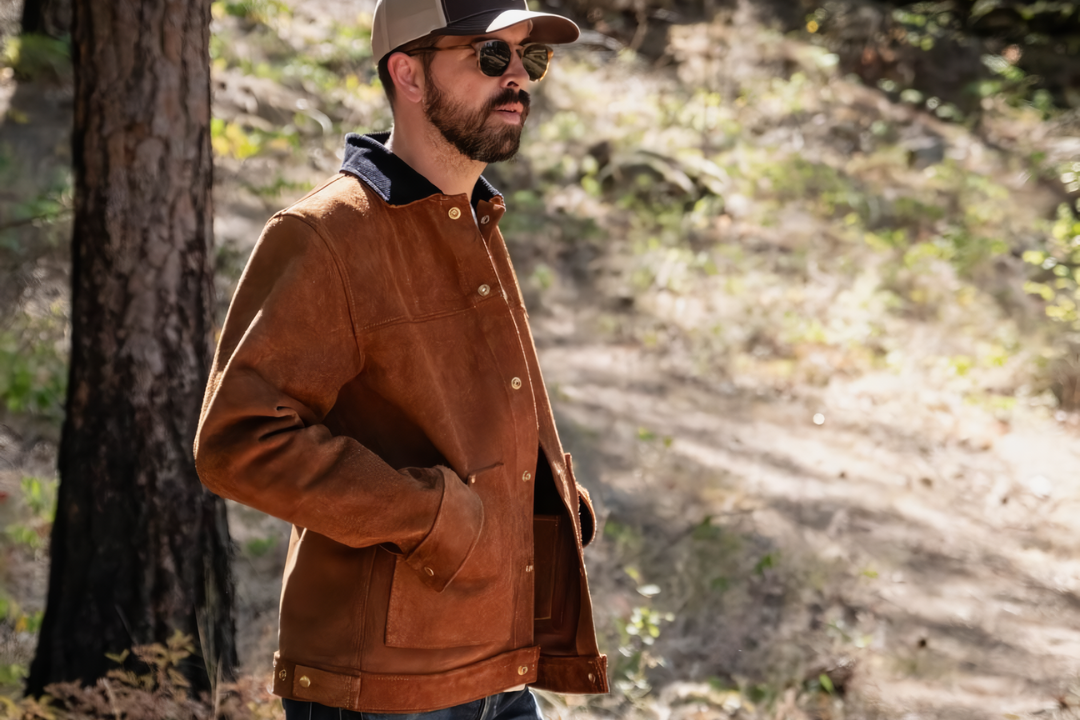Key Takeaways:
- Why Fit Matters: A well-fitted leather jacket enhances comfort, style, and functionality, making it a versatile wardrobe staple.
- Key Fit Areas: Focus on shoulders, sleeve length, and waist for a balanced, structured look that allows natural movement.
- Style-Specific Fit: Different leather jacket styles, like bikers or bombers, offer unique fits. Choose one that aligns with your body type and needs.
The perfect fit is real.
It’s more than finding your size — finding a jacket implies a natural extension of yourself, balancing comfort with timeless style. A poorly fitted jacket can compromise look and function, making you feel restricted rather than empowered.
At Nicks Boots, we take pride in crafting jackets that do more than look good; they’re made with full-grain leather, designed to last, and built to stand the test of time. Each piece reflects our commitment to quality and unmatched craftsmanship.
In this guide, we’ll explore what it takes to find the perfect fit for your leather jacket.
Why Fit Matters For A Leather Jacket
A well-fitted leather jacket is essential because it influences both comfort and functionality. The right fit allows for natural movement, preventing that stiff, restrictive feeling that can come with an ill-fitting jacket. Beyond movement, a properly sized leather jacket also provides better insulation and protection from the elements, making it more versatile for various weather conditions.
Additionally, fit impacts the jacket's look, highlighting your build and giving you a confident, polished appearance. A too-loose jacket can appear sloppy, while one that’s too tight may feel constraining and prone to wear in high-stress areas. Choosing the correct fit isn’t just about aesthetics; it’s about getting lasting wear and maximizing comfort every time you wear it.

Key Areas To Assess For The Perfect Fit
When assessing a leather jacket for the ideal fit, it’s essential to evaluate specific areas contributing to comfort, functionality, and appearance. Each part plays a role in achieving that seamless blend of style and ease from the shoulders to the waist. Here’s a breakdown of the critical areas to examine:
- Shoulders: The shoulder fit is foundational for any leather jacket. The seam should sit right where your shoulder naturally ends, aligning perfectly with your body. A shoulder seam that’s too wide will cause a sagging look, while one that’s too tight can restrict movement and may lead to early wear in high-stress areas.
- Arm Length: Getting the sleeve length right is essential for comfort and style. Ideally, the sleeves should reach the wrist bone when your arms are relaxed at your sides, providing full coverage without excess length. Too-long sleeves can look unrefined and interfere with hand movements, while too-short sleeves expose your wrists, compromising warmth and style.
- Chest: A properly fitted chest area allows for ease of movement and a flattering silhouette. There should be enough room to move comfortably, whether your jacket is zipped up or open. Too tight can restrict breathing and movement; the coat can lose its structure and shape if it’s too loose.
- Waist: The jacket's waist should contour slightly, following your body's natural lines without clinging too tightly. A fitted waist helps structure the chest and shoulder areas while avoiding a boxy appearance. A well-defined waist can create a sleek, tailored look that enhances your overall style.
- Jacket Length: Length is a final factor in achieving the perfect fit and often varies with jacket style. Generally, the jacket should hit around the hip level, which provides a balanced look for most body types. A longer jacket may look disproportionate, while a too-short length can expose the midsection, reducing coverage and overall appeal.
Leather Jacket Styles And How They Affect Fit
Different leather jacket styles bring a unique fit and aesthetic, influencing comfort and mobility. From classic bikers to refined bombers, understanding these styles helps you select a jacket that aligns with your personal and functional needs. Here’s a look at popular leather jacket styles and how they impact fit:
Biker Jackets
Biker jackets are designed with a close fit, often with an asymmetric zipper for added flair and function. They typically have a snug fit at the shoulders and chest to prevent wind resistance, making them ideal for motorcyclists. This style works best when worn closely fitted, enhancing a sleek silhouette that’s also functional for movement.
Bomber Jackets
Bomber jackets offer a more relaxed fit than biker styles, focusing on comfort and warmth. They are generally roomy around the chest and waist, with ribbed cuffs and hems that provide a structured look without restricting movement. This versatile style suits various body types, providing a comfortable yet polished appearance.
Cafe Racer Jackets
The cafe racer style is known for its minimalist design and close fit, featuring a straight zipper and minimal embellishments. These jackets hug the body, especially around the chest and shoulders, to maintain a streamlined look. Cafe racers are ideal for those seeking a refined, tailored appearance without excess bulk or detailing.
Flight Jackets
Initially designed for pilots, flight jackets offer a more generous fit that allows for layering. They’re typically roomier around the torso with a longer length, which provides added coverage and warmth. This style is perfect for colder weather and offers a classic, rugged appeal that complements bulkier builds.
Field Jackets
Field jackets provide a looser fit with multiple pockets, combining utility with style. They’re typically longer in length, extending below the hip, and are designed to layer comfortably over thicker clothing. This style suits outdoor activities and adds a functional, rustic look to the wearer’s wardrobe.
Choosing The Right Fit For Your Body Type
Choosing the right leather jacket fit involves understanding how different styles suit various body types. Each body type benefits from specific cuts and structures that enhance natural proportions and optimize comfort. Here’s a guide to finding a flattering fit based on common body shapes:
Athletic Build
For an athletic build with broader shoulders and a narrower waist, jackets that taper slightly at the waist can highlight this natural shape. Styles like the cafe racer or fitted biker jacket work well, creating a streamlined look without adding bulk. Avoid overly loose fits, which can obscure the definition and disrupt the jacket’s silhouette.
Slim Build
Those with a slimmer build may benefit from jackets with a slightly relaxed or straight fit to add dimension without overwhelming their frame. Bomber or flight jackets are ideal, as they offer more structure and volume around the chest and shoulders. These styles add balance, providing a classic look without making the jacket appear oversized.
Broad Or Stocky Build
For broader or stockier builds, it’s best to look for jackets with more room in the chest and waist for comfort and mobility. Field or bomber jackets work well, offering enough space without feeling restrictive. Choose styles that allow for natural movement while avoiding overly tight cuts, which can accentuate bulk.
Tall Build
Taller people benefit from slightly longer jacket styles that provide balance and proportion to their height. Field and flight jackets, with extended lengths and a structured fit, are great choices, as they offer a balanced look from top to bottom. Avoid cropped styles, which can throw off proportions and create a top-heavy appearance.
Tips For Trying On And Adjusting Your Leather Jacket
When trying on a leather jacket, assessing comfort, fit, and flexibility is essential to ensure it meets your needs. Each area, from the shoulders to the waist, plays a role in achieving that perfect fit. Here are key tips for trying on and adjusting your leather jacket:
Wear Your Usual Layers
When trying on the jacket, wear the type of shirt or layers you typically wear underneath. This helps you gauge how the jacket fits with additional layers, preventing surprises later. Wearing familiar layers also lets you see how the jacket complements your regular wardrobe.
Test Range Of Motion
Move your arms, bend your elbows, and even try reaching overhead to ensure the jacket doesn’t feel restrictive. A well-fitted jacket should allow full movement without tightness in the shoulders or chest. This quick mobility check ensures comfort, especially for extended wear.
Check Shoulder And Arm Fit
The shoulder seams should sit right at the end of your natural shoulder line for a balanced look. Similarly, the sleeves should fall at the wrist bone when your arms are relaxed, providing coverage without excess fabric. A proper shoulder and sleeve fit is essential for a polished appearance and comfort.
Assess Comfort When Zipped Or Buttoned
Zip or button the jacket to evaluate how it feels when closed. There should be enough room in the chest and waist for comfortable movement without tightness. Ensuring it feels just as comfortable zipped up prevents issues with restricted movement or discomfort.
Allow For A Slight Break-In Period
Leather jackets naturally soften and mold to your body over time, but they shouldn’t feel overly tight initially. Opt for a snug yet comfortable fit, allowing room for the leather to adapt without compromising initial comfort. This approach ensures that your jacket will feel even better with wear.

Final Thoughts
A well-fitted leather jacket is a lasting investment that embodies quality, style, and individuality. Choosing the right jacket allows you to create an effortlessly classic look, blending form and function to suit a range of occasions. The right fit enhances your style and feels like a natural part of your wardrobe, providing comfort and versatility year after year.
Read also:
Frequently Asked Questions About Leather Jacket Fit
What should I wear when trying on a leather jacket?
It’s best to wear similar layers to what you’ll typically pair with the jacket, like a T-shirt or a light sweater. This helps you understand the fit and how the jacket accommodates layers for warmth or style.
How tight should a leather jacket be initially?
When new, a leather jacket should feel comfortably snug without squeezing. Leather naturally loosens over time, so starting with a closer fit helps the jacket mold to your shape without becoming too loose.
Should a leather jacket allow for a full range of motion?
Absolutely; you should be able to move your arms without tightness in the shoulders or chest. Testing the range of motion ensures comfort for daily wear, especially if you’re active or need the jacket for colder weather.
How long should the sleeves of a leather jacket be?
Ideally, the sleeves should reach your wrist bone when your arms are relaxed at your sides. This length offers full coverage and a balanced look without the fabric bunching or restricting hand movement.
Is it better to size up for layering?
Sizing up can help if you plan to wear thicker layers beneath, but avoid going too large, as an oversized jacket may lose structure. Aim for a comfortable fit with a layer while still looking tailored.
Do different leather jacket styles have unique fits?
Yes, each style has its unique fit — biker jackets tend to fit snugly for wind resistance, while bombers or flight jackets are more relaxed for comfort. Choosing a style that aligns with your body type can enhance style and functionality.
How do you know if the shoulders fit correctly?
The shoulder seams should align precisely with the end of your shoulder bone, creating a clean and structured appearance. A misaligned shoulder seam can affect comfort and the overall look, making the jacket appear too big or tight.
What if my leather jacket feels too long or short?
Leather jackets generally look best when they hit around the hip level, providing a balanced silhouette. If they’re too long, they may look oversized, and too short can compromise warmth and style, especially in colder seasons.
Does leather stretch over time?
Yes, genuine leather naturally stretches and softens, conforming to your body’s shape with wear. Starting with a snug fit allows this process without the jacket becoming too loose, so aim for initial comfort with room to break in.
Can leather jackets be tailored for a better fit?
Tailoring is possible, especially for adjustments like sleeve length, but due to the nature of leather, it requires expertise. Simple alterations are feasible, though significant changes might be limited to preserve the jacket's integrity.





































